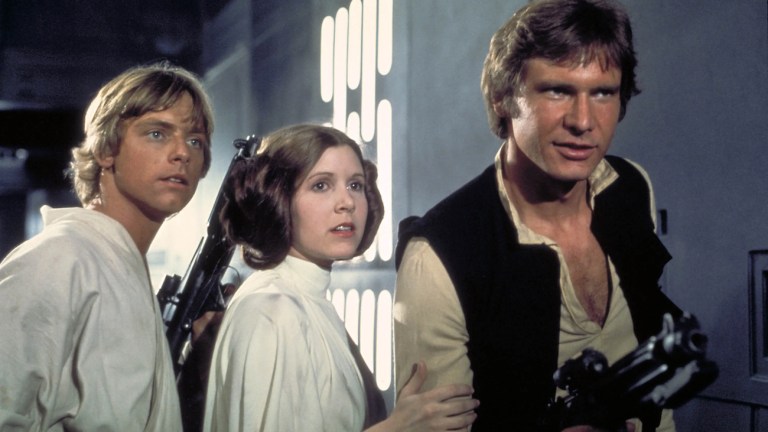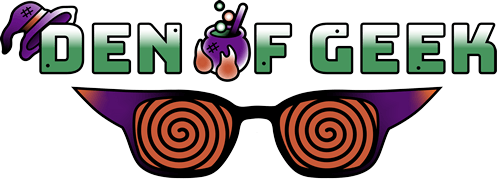When Did the Original Star Wars Become ‘A New Hope?’
Everyone now refers to the first Star Wars movie as “A New Hope,” but it took decades for that idea to catch on…

From its original paradigm-shifting release in 1977 to right up until George Lucas sold Lucasfilm to Disney in 2012, the filmmaker behind that galaxy far, far away was always tinkering with the original Star Wars, aka Episode IV: A New Hope. In the minds of most fans this begins insidiously during the moment where Greedo is changed to shoot first in the 1997 theatrical re-release of A New Hope, and it continued on all the way until the third film in the original trilogy, Return of the Jedi (1983), saw Hayden Christensen digitally inserted into the denouement of the same movie in 2005. But the truth is Lucas was never entirely satisfied with the three films that launched his billion-dollar empire, and the legacy of that continues to this day in how folks even refer to them.
For moviegoers of a certain age—namely those who were alive when the first movie premiered in 1977—that picture will always be Star Wars. And in their defense, that is all the title card said during the now legendary opening crawl: “STAR WARS.” They’re the words that changed the way American audiences thought about going to the movies, and those associated with Hollywood’s slow but ceaseless transition toward franchise entertainment and modern special effects spectacle.
When millions upon millions of moviegoers bought tickets again and again to that film—making it still the second highest ticket-seller in U.S. history when adjusted for inflation—they did so to see Star Wars. Yet their children, and grandchildren, rarely think of one movie when the words “Star Wars” are uttered. Instead the title signifies the brand name of an entire “universe” of interlinking intellectual property that encompasses everything from movies to television shows, to video games, to theme park rides, to pillows and Pez dispensers. And under this large umbrella, the most historically significant Star Wars movie is just that… a Star Wars movie. It’s also one that due to the retroactively added “Episode IV” subtitle is now even viewed as the fourth movie in a chronological saga.
How did this happen?
The ‘A New Hope’ Change
The first time Lucas’ Star Wars hit cinema screens, as well as its first spate of re-releases in 1978 and 1979, a moment where 20th Century Fox cemented its dominance of the highest grossing movie ever up to that point, there was no “A New Hope” subtitle nor an “Episode IV.” So the inclusion of those qualifiers became the first substantial, yet still relatively discrete, change Lucas made to the picture.
The shift occurred in 1981 during the film’s third re-release. By this time, Lucas’ The Empire Strikes Back had been released the previous year, and with it Lucas settled on explicitly suggesting that audiences were coming into the middle of a “saga,” just like the old Saturday morning matinee serials he would watch as a kid, often out of order or while skipping key installments from week to week.
Hence The Empire Strikes Back’s full title, Star Wars: Episode V: The Empire Strikes Back. Ergo, to align Star Wars with this idea, the choice was made to include a detail that casual moviegoers generally ignored for the next decade or two: the subtitle of “A New Hope.” It was actually the first in a handful of changes Lucas made to the 1981 re-release of the movie, which also included subtly redone sound effects, more Wookiee noises, and even alternate takes of dialogue that Lucas decided he preferred to what was used in the ’77 theatrical release.
The Implications for a Star Wars ‘Saga’
The full extent of the logic behind Lucas turning Star Wars into a saga, where the then incredibly popular spate of films would be rejiggered as episodes four through six, remains somewhat elusive. Despite the more streamlined marketing suggestions of the 2000s where Lucas asserted during the release of the Star Wars prequels that he always had a clear vision of what each film’s story would be since day one, the truth is the creative process was likely much more fluid, with Lucas giving conflicting accounts of what the original sequels would be or, indeed, how many potential movies beyond the initial Star Wars trilogy he intended to make.
For example, in 1980, the same year that The Empire Strikes Back came out, Lucas told Prevue magazine (via The Secret History of Star Wars) that he was toying with the idea of making two spinoff films after his then developing Star Wars trilogy that would be about Wookies and droids. Indeed, Lucas even suggested the idea would’ve excluded any human characters… and he was also bouncing around the idea of two other Star Wars trilogies. Maybe.
“When I got to working on the Wookiee, I thought of a film just about Wookiees, nothing else,” Lucas said. “So, for a time, I had a couple of odd movies with just those characters. Then I had the other films which were essentially split into three parts each, two trilogies.” Lucas seemed to be grappling with how big his “saga” would become after The Empire Strikes Back’s sequel. And between 1980 and 1983, the idea became increasingly to do two more trilogies—one about Obi-Wan Kenobi as a young man in those early stages and another about Luke Skywalker as an older man who was about the same age as Obi-Wan in the original Star Wars, passing down what he has learned. Lucas even considered an epilogue set of films early on, which could’ve taken the series up to Episode XII! So as a commercial prospect, it became useful to start stressing Star Wars as the “middle” of a larger story. Hence it became Episode IV.
By 1983, Lucas was even telling Time magazine (via us!) that they’d be about “moral choices and the wisdom needed to distinguish right from wrong.” He envisioned Luke in his 60s and his adventures being told, again, from the perspective of R2-D2 and C-3PO.
In 1999, Gary Kurtz, the producer of the first two Star Wars movies, even stressed to TheForce.net that there were already loose ideas in 1980 for the sequel trilogy, including Luke discovering he had a long lost sister in Episode VIII who he’d never met before (an idea that may have transformed into the unlikely revelation that Princess Leia was his twin in Return of the Jedi).
But also by the time of that ’83 picture, plans changed again with Lucas telling Time that he felt “burned out” on Star Wars. And later he shifted his opinion to thinking he only needed two trilogies in which, retroactively, Anakin Skywalker became the main character. As a consequence, the Star Wars saga became about following Anakin from childhood through to his redemptive death in Return of the Jedi. And by making the prequels that confirmed this, it shifted the first Star Wars’ perception for many younger fans from being a standalone space adventure epic that changed cinema history to it just being the fourth “episode” in Lucas’ larger vision—a cog in a machine.
But When Did the New Title Really Catch On?
Technically speaking, Star Wars has been A New Hope since 1981. However, anecdotally as someone who grew up in the ‘90s and 2000s, I can say from my own memories that only the real diehard fans of the Star Wars brand—readers of the Expanded Universe novels and connoisseurs of Star Wars encyclopedias—referred to the original movie as “A New Hope.” To the vast majority of folks, it was still simply “Star Wars.”
And it would seem that’s how it was largely marketed by Lucasfilm until Lucas himself came back around to making that prequel trilogy and emphasizing the “Episode IV” of it all.
Indeed, while fans and Lucas-approved merchandise might’ve referred to it as “A New Hope,” the first film continued to be sold to mainstream audiences as simply Star Wars for decades. Ahead of the now infamous 1997 theatrical re-release of the movie—which is the one where Greedo began shooting first—the below trailer hyped audiences by lamenting that younger audiences (like myself) were “an entire generation [who] experienced Star Wars the only way it’s been possible: on the TV screen.” The trailer’s voiceover talent practically sneers the word TV. “But if you’ve only seen it this way, you haven’t seen it at all.”
By the end of this trailer, that disembodied voice proudly announces the release dates for each of the original trilogy films returning to theaters, beginning by trumpeting, “On Feb. 14, Star Wars, followed soon after by The Empire Strikes Back!” And when those same digitally altered versions of the trilogy were released in a gold-hued VHS package later that year, the first film was simply called Star Wars: Special Edition on the box art.
By this point, Lucas knew he was making the Star Wars prequels, however he was still leaning into audiences’ familiarity and nostalgia for their re-releases. Prior to the re-releases, the trilogy in its original relatively unaltered form had been released on VHS (the last time those versions would be made widely available), and the spine of the first film’s box art included the words “A New Hope.” However, the main cover of that VHS release (and the overarching box art for the whole trilogy package) referred to it simply as “Star Wars.” But the much more hyped special editions decided to leave “A New Hope” out entirely, even on the spine. And much to many fans’ continual dismay, those special edition re-releases on VHS became the only widely available home media iterations of the trilogy for nearly a decade… even as the cover art did eventually change.
In fact, Lucas waited until he was in post-production on Revenge of the Sith to finally release the Star Wars trilogy on DVD in 2005 (one wonders if he might’ve been less patient if knew the home media market would implode about five or six years after that). And during that first digital re-release, the box art for the 1977 classic now emphasized “IV” with the largest lettering on the case. Meanwhile “A New Hope” was proudly emblazoned beneath the Star Wars logo, making it indistinguishable from how The Empire Strikes Back or Attack of the Clones were titled on their corresponding and matching DVD cases.
In order for Star Wars to expand as an ever-growing intellectual property, the original movie’s title needed to be buried. And to Lucasfilm’s credit, and later Disney’s, it worked. Less than 20 years later, it’s both quaint and confusing to refer to the original movie as Star Wars in a world with a haphazardly realized sequel trilogy—one that also rips away Anakin’s relatively new protagonist status from Lucas. Now the creator’s “Star Wars Saga” has been repackaged as “the Skywalker Saga,” making room for two spinoff films, six Disney+ shows, and surely much more to come.
Nothing can be just Star Wars when everything is.

